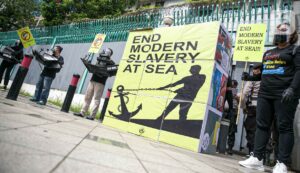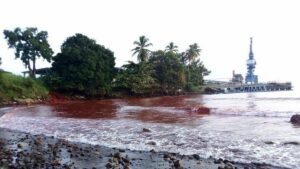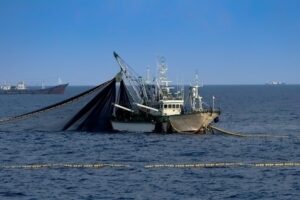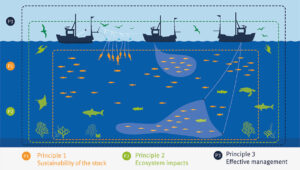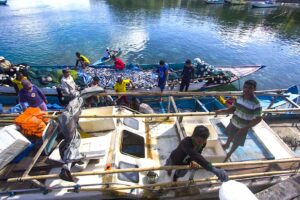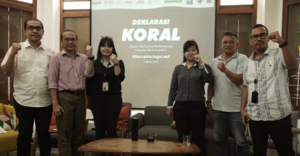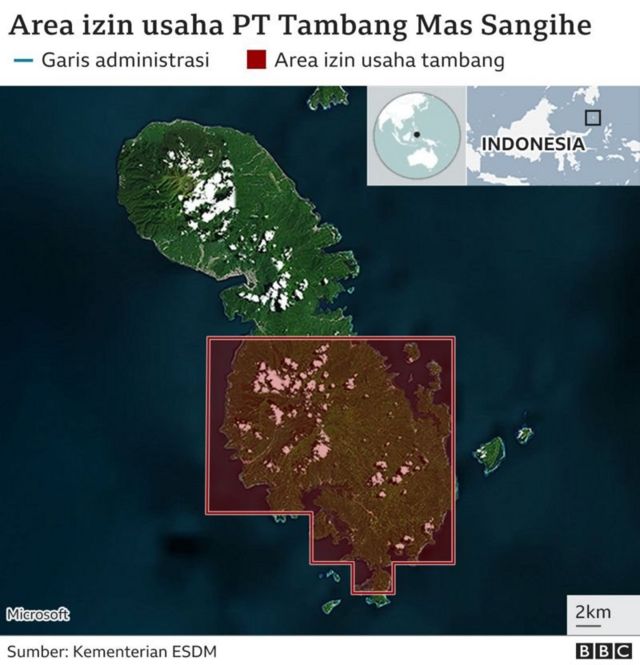
Yet another environmental tragedy has happened before our eyes. Gold mining activities on the Island Sangihe North Sulawesi, which has caused massive environmental pollution, has been talked about a lot lately. In April 2021, more than half of Sangihe Island was declared as a region PT Tambang Mas Sangihe (TMS). This was stated by a member of the DPRD North Sulawesi, Winsulangi Salindeho, from the constituency North Nusa (Sangihe, Sitaro, and Talaud), when interviewed by Kompas. With a management permit that will last approximately 35 years, the threat of damage that can happen in this 737 km² island will certainly be even greater.
Sangihe Island is located in earthquake-prone coordinates, and data from the Center for Volcanology and Geological Hazard Mitigation (PVMBG) of the Geological Agency of the Ministry of Energy and Mineral Resources (ESDM) shows that the Sangihe area is generally composed of hilly morphology covered in young volcanic debris, valleys, and plains in coastal areas which are quaternary deposits (river deposits, beaches, volcanic rocks) that have undergone weathering. The rocks that make up the soil morphology in the area are loose, soft, unconsolidated or not yet compact, and strengthen the effects of shocks so that they are prone to earthquakes. The Sangihe Archipelago is also famous for its many rivers that disgorge and empty into the sea waters of the island. Earthquake-prone and loose and soft textured soil makes the risk of mining waste leaking and causing ecological damage quite high.
The gold mining case in Sangihe is inseparable from the unclear and inconsistent implementation of the Coastal and Small Islands Zoning Plan (RZWP3K). According to Law No.1 of 2014 concerning the Management of Coastal Areas and Small Islands, it is said that small islands may not be used as mining areas. According to Article 1 of this Law, a small island is an island with an area smaller than or equal to 2,000 km². Based on this, it is clear that Sangihe Island fits the criteria. According to the same law, small islands and the waters around them are supposed to be used for 9 types of interests, such as conservation, education and development, and marine cultivation.
A similar case has also occurred in Southeast Sulawesi, namely on Wawonii Island, an island of only 867 km² that has become a nickel mine owned by PT Gema Kreasi Perdana. Not only is the company openly violating the law, the company has also built a special terminal that transports nickel mining products outside the island and the “chosen” location is included in the zone for general use and capture fisheries, which also violates the rules of RZWP3K.
Caption: Trucks carry out nickel ore transport activities to barges at a mining company in North Konawe Regency, Southeast Sulawesi (Image: Antara)
PT Tambang Mas Sangihe has obtained a permit for more than 30 years to operate on the island. Meanwhile, according to Law No. 3 of 2020 concerning Amendments to Law No. 4 of 2009 concerning Mineral and Coal Mining, a mining permit contract of work can only be extended for a maximum of 2 times every 10 years or equal to a maximum of 20 years. How exactly the company was able to obtain a contract with a duration more than the legal provisions is unclear.
What is still unconfirmed apart from that is the mining area itself. It is possible that practices found in Wawonii Island will be repeated: capture fisheries areas being used as a transportation route for mining products or a waste disposal route, resulting in a massive environmental degradation.
Again, the location of Sangihe Island, which is in an earthquake-prone area with two large plates of Eurasia and the Pacific, makes mining projects more at risk of waste leakage and collapse that threatens the lives of workers and residents.
The Mining Advocacy Network (JATAM) has found that 55 small islands in Indonesia have been exploited for mineral and coal mining. JATAM also revealed that PT Tambang Mas Sangihe is a company made up of a Canadian company, Sangihe Gold Corporation, which is the majority shareholder of 70%, and three Indonesian companies. It has held a Generation VI Contract of Work (KK) since March 17, 1997, has received environmental feasibility approval from North Sulawesi Province on September 25, 2020, and a production operation permit from the Ministry of Energy and Mineral Resources (ESDM) earlier this year. This means that, consciously, the Government gives the company a right to exploit gold and copper in six sub-districts which are divided into 80 villages over the next 33 years which have the potential to bring the island into the shackles of short and long term damage.
Sangihe residents in the Save Sangihe Island movement, which consists of 25 community organizations, continue to voice their rejection and massive protest against the existence of this mine. Residents are afraid, disturbed, and worried that their ancestral lands will be damaged, starting from seawater contaminated with sewage, contaminated groundwater becoming toxic, plantations and green hills being cleared away, endemic mountain-dwelling animals being extinct, and traditional livelihoods. the majority of the population disappeared. In addition, the Sangihe Islands Regency Government also denied involvement in the process of obtaining environmental and exploitation permits issued for PT Tambang Mas Sangihe.
A spokesman for the Save Sangihe Island movement, Samsared Barahama, said there were several reasons the gold exploitation plan in Sangihe had to be rejected. According to him, the production permit area granted is 42.000 hectares or half of the area of Sangihe Island which is inhabited by more than 131.000 people. In addition to not meeting the criteria and permits according to the law, this mining activity will damage the protected forest area of Mount Sahendaruman which is the habitat of the endemic animals of Sangihe Island and also a source of water for the community. Moreover, in the process of compiling an environmental impact analysis (AMDAL), the Sangihe community did not involve the people of Sangihe, especially those who live in ring-1 around the mine.
Caption:Makassar New Port development plan which takes sea sand from the area around Kodingareng Island, Makassar, South Sulawesi. (Image: MEMR)
Besides gold mining, nickel and sand mining are also still rife in various islands and territorial waters in Indonesia. In the case of Sangihe, the environmental permit was issued before the community was aware of the existence of a gold mining project in their area. The licensing process, which excluded local residents in the preparation of the AMDAL, raises the question: what are the government and companies deliberately covering up?
However, government-licensed mining is not the only problem we face. Illegal mining operating around the island must also be dealt with firmly. This is for the safety of workers, law enforcement, and of course environmental sustainability. The government must be firm and stand firmly in preserving the environment by consistently implementing laws and other legal instruments without selective logging. Justice for nature and local communities is the number one priority, not positive sentiments from investors and foreign countries.
